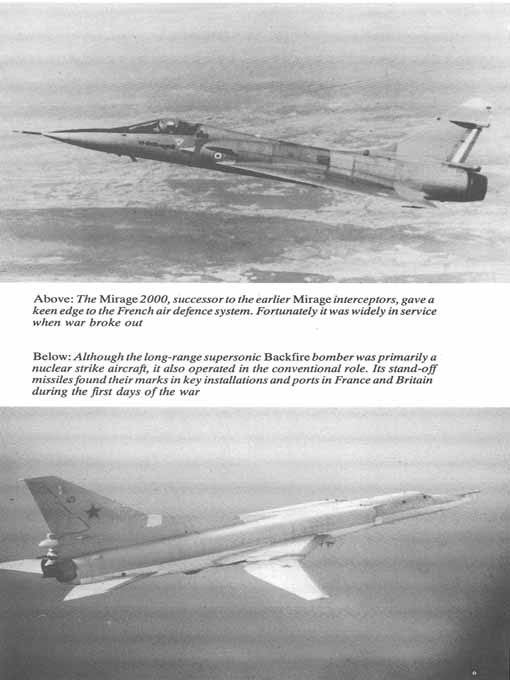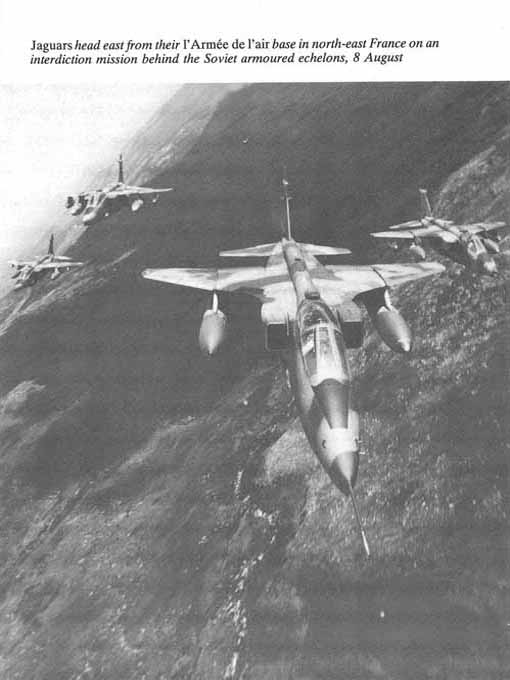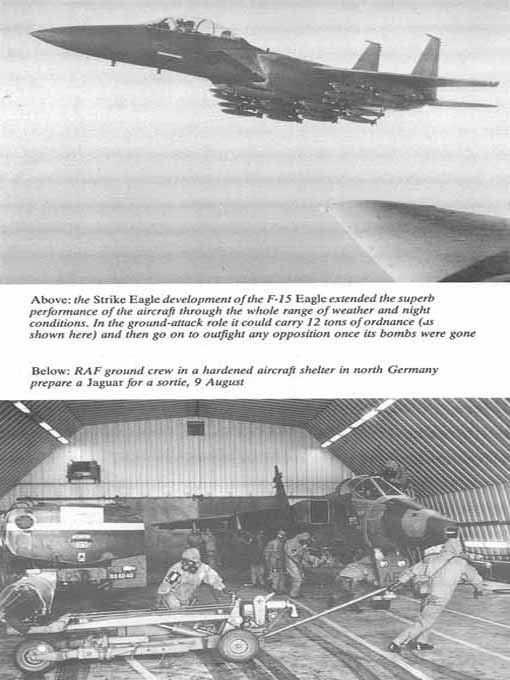The Third World War - The Untold Story (13 page)
Read The Third World War - The Untold Story Online
Authors: Sir John Hackett
Tags: #Alternative History


The British and German dilemma was critical. The turn of the decade saw a conservative government in Britain (as in the USA) committed to defence improvement. The United Kingdom soon ran into budgetary difficulties, while in Germany economic stringency and the soaring costs of the
Tornado
had already produced a virtual freeze on all air force procurement plans.
It was here that the Spinney Report made a quiet but telling entry. Franklin C. Spinney, an analyst, headed a research team in the USA tasked by the Pentagon with analysing the day-to-day availability of tactical aircraft. He unearthed some disquieting facts, not least that the reliability and serviceability factors for USAF front-line aircraft were far below what would be needed for intensive operations in war. Spinney concluded his astringent report in 1980 with the painful conclusion that ‘Our strategy of pursuing ever-increasing technical complexity and sophistication has made high technology solutions and combat readiness mutually exclusive.’
This conclusion, although unlikely to be universally true, chimed sufficiently well with the experience of the air forces of the larger powers to make the report very uncomfortable reading. Although obviously unwelcome, the report was taken seriously and had a significant impact on later events. Understandably, it was played down publicly and those few commentators in the media who latched on to what sounded like bad news missed the point that Spinney had been inveighing against complexity rather than high technology. There could be no question of air power turning its back on science and technology, for to do so would be to turn its back upon itself. In different ways, however, and sometimes for different immediate reasons, the Allied air forces started taking account of what Spinney had said.
While the big increases in the US defence appropriations for fiscal years (FY) 1980 and 1981, and their five-year projections, swung resources for the US AF back to the strategic elements (for well recognized politico-strategic reasons) they still left substantial room for improvements in the tactical forces. These took the form of further purchases of F-15
Eagle
and F-16
Fighting Falcon
fighters, more A-10
Thunderbolts
and eight more KC-10 air refuelling tankers, which were to be so important for the trans-Atlantic reinforcement of Europe by fleets of tactical bombers and fighters. In FY 1983, perhaps with an eye to Spinney, no less than $3.6 billion was included for increased spare-part holdings and reliability improvements.
By the start of the war some of the US AF’s A-10
Thunderbolts
had been given a bad-weather and night capability, but so had the Soviet SAM, so that any advantage to the A-10s was to some extent offset. When surprise was achieved, or the enemy defences were degraded, the
Thunderbolts
with their massive firepower could wreak havoc on the enemy’s armour, but in less favourable circumstances their losses would be almost too heavy to sustain. It was with some misgivings about the likely loss rate that the staffs of 4 Allied Tactical Air Force (ATAF) and CENTAG had approved, a year or so before the war, a programme of tactical trials to modify their existing co-ordination between the US Army anti-tank helicopters and the USAF
Thunderbolts.
The approved doctrine hitherto was for the helicopters, hovering in ambush, to open fire on the armour with their guided weapons for thirty seconds before the
Thunderbolts
came in, and then to pop up again to give the surviving tanks another thirty seconds’ worth when the
Thunderbolts
had finished. The idea came from the US Army
Cobra
helicopter pilots that their own effort might be better directed at the easily recognizable Soviet ZSU radar-controlled anti-aircraft guns and SAM vehicles which would be providing the tanks with anti-air protection. If they did that, it was argued, the
Thunderbolts
would have, if not an unrestricted, at least a much less fiercely opposed run at their targets. Ground force commanders were sceptical. The threat was from the tanks and there would never be enough anti-tank weapons in the right place at the right time. What there was should be directed at the main threat. The
Thunderbolts
might not arrive anyway.
The trials were promising, but without real action no one could be sure what would be best. In the event, adoption of the new tactics was at first cautiously limited to the new Hughes AAH-64 helicopters of 8 Aviation Combat Division of the US Army Air Corps at Finthen, Germany, working with USAF
Thunderbolts
deployed forward to Germany from their English base in East Anglia. The wooded knolls around Fulda, for example, were to give excellent cover to the ambushing helicopters with their
Hellfire
missiles, and the enemy’s defence vehicles were, as predicted, clearly visible against the squat Soviet T-72 tanks and BMP around them. With the ground defences at least temporarily stunned and degraded, the
Thunderbolts,
in relatively slow runs, could concentrate their fire with deadly effect against the tanks. Happily it had just been possible in the two years before the war to extend these tactics widely. Helicopter attack on tanks, sometimes in conjunction with A-10
Thunderbolts,
on the lines worked out between the US Army Air Corps and the USAF were to be a frequent and powerful element everywhere along the Central Front.
The five-year projection in FY 1983 also provided for substantial increases in USAF flying hours, which had been cut back, just as they had been in European airforces, to dangerously low levels under budgetary pressures in the late 1970s. While this USAF programme was one to excite the envy of airmen across the Atlantic, much of its emphasis was nevertheless consistent with what Europe was having to do - namely, enhance and develop what already existed rather than insist in vain on new types.
The RAF was the only air force in the alliance to operate all the roles of air power (in the USA the maritime role was discharged by the US Navy Air Force). It is therefore instructive to look back at some of its problems in the five years before the war.
Although the British Government endorsed and generally adhered to the 3 per cent annual growth of defence spending in real terms agreed by the NATO Council in 1977, each year saw greater difficulty in containing the programme costs within the increased defence budget. Something always had to be dropped or deferred. A formidable ‘bow wave’ of unfulfilled operational requirements was being pushed ahead of the defence programme. As economic pressures increased, existing capabilities had then to be trimmed back because of rising running costs - a process that came to be termed rather bitterly in British defence circles ‘salami-slicing’. As matters got worse in the years of economic recession, flying hours and ground transport fuel were cut and (almost incredibly) officers and men were sent on leave to save money. The shoe, and more especially the flying boot, was pinching hard.

As in the USAF, the RAF had suffered a drain of experienced air crew in the second half of the seventies because pay and prospects compared badly with those to be found in civilian life in times of some economic buoyancy. Experience levels in the front-line squadrons began to cause anxiety, and subsequent cuts in flying and training, although effective enough in saving money on current account, were to cast a long and dangerous shadow over the force in the immediately following years. It fell to the British Defence Secretary to take a serious look at this declining situation in the summer of 1981 after yet another of a long series of what the British called ‘Defence Reviews’ -a well understood euphemism for further cuts in the defence programme. This time the review cost Britain 20 per cent of its naval surface fleet. As the Royal Navy was the major contributor to NATO’s Eastern Atlantic (EASTLANT) and Channel forces this in turn meant a cut of some 15 per cent in available surface escorts in the EASTLANT area.
The other two British services did not go unscathed but the RAF was at least authorized to keep in service two squadrons of
Phantom
fighters that would otherwise have been phased out. These were to augment the air defence of the United Kingdom and spoke for a proper recognition of the crucial importance of the British Isles in war as a forward base for United States land and air reinforcements and a rearward base for the air forces of the Supreme Allied Commander Europe (SACEUR) should things go badly on the ground in Germany.
Explicitly the review laid stress on increasing weapon and logistic stocks. Implicitly it was an acknowledgement that if war should come to Europe it was likely to go on rather longer at the conventional level than previous planning and provisioning had been prepared to admit. If ever there should be good reasons for ‘going nuclear’, running out of ammunition and other war stocks after a few days should not be allowed to be among them.
The shock of the naval cuts was sharp but as the pain wore off it came to be seen that there was an inevitability about what had happened. At last realities were being faced, including the central one that the cost-growth of technology was going through the roof while most of the world was running out of money. Those who took any interest in current affairs knew that the strategic and theatre nuclear balance was unfavourable to the Alliance at the end of the 1970s. Until that imbalance was redressed by reductions on the Soviet side or new deployments on the Allied, the next six or seven years would indeed offer, in the now currently accepted phrase, a window of opportunity for the Soviet Union. The dangerous years were now upon the Alliance and its air forces had to take a long, cool look at the situation.
Using once more the British model, things would have been a lot worse but for the sound foundations laid in the seventies. Aircraft such as the
Tornado,
the
Nimrod
in its maritime and airborne early warning (AEW) roles, and the latest
Blindfire
all-weather version of the
Rapier
air defence missile, were among the leaders in the world league. Apart from having to keep the older aircraft in service much beyond what was originally planned, some other weaknesses lay in the increasing vulnerability to the developing Soviet Air Force of airfields in the UK and the shortage of alternative bases for dispersal - especially with the need to accept large reinforcements from the United States in war and the possibility of rearward redeployments of aircraft from the continent of Europe. Average experience levels in the front-line squadrons in some roles were uncomfortably low and the big gap for the rest of the decade was going to be the lack of a current-generation tactical fighter for operations over the forward area in Germany. It must also be said that ECM equipment, while all right as far as it went, was well behind the general state of this important art. Precious little extra resources would be forthcoming -that much was clear - and remedies would have to be sought by making better use of what there was or what was in near prospect.

Inevitably some good came from this enforced period of austerity. Some of the changes it imposed were radical. The opening of all ground branches not involved in direct combat duties to women, for example, tapped a reservoir of valuable recruits. Similarly, wider uses were found for auxiliaries and reservists of both sexes to considerable advantage. The USAF went further, in allowing women to be employed on flying duties. It was not long before this was extended to combat duties. In fact, it was a 29-year-old woman who was to lead the first offensive action from the United States in the Third World War. This deserves closer attention.
